“Whatever happened to all those old saddle tanks? We haven’t seen any
of them in years.”
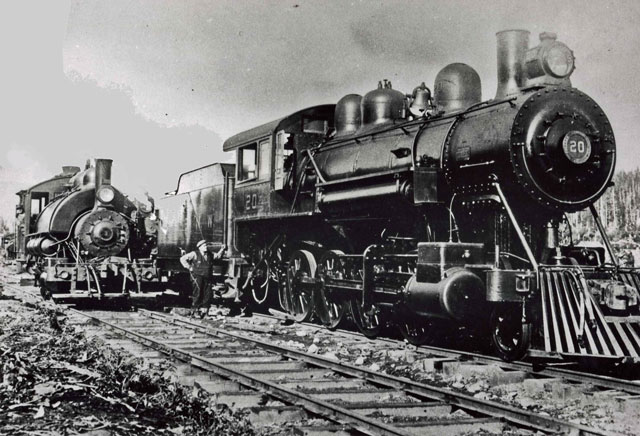 |
Dinkey engine #3 along side CRNW
consolidation engine #20. --UAF Archives
BELOW: detail shot of the "dinkey" saddletank engine shown in
the above photo. |
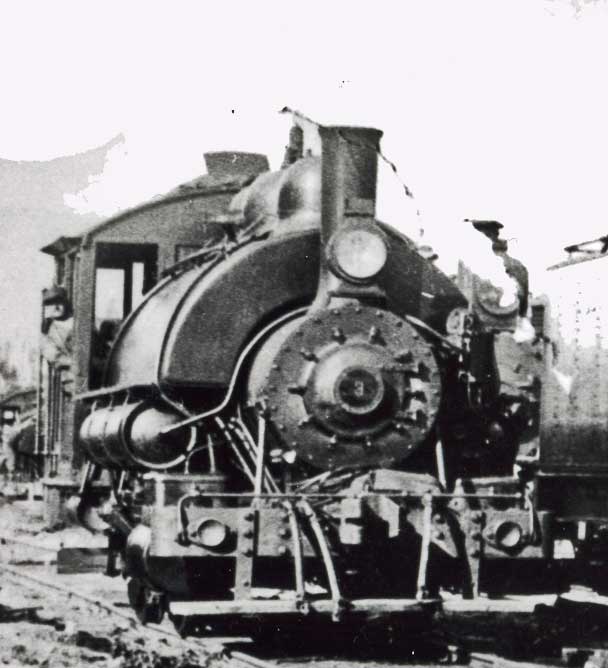 |
|
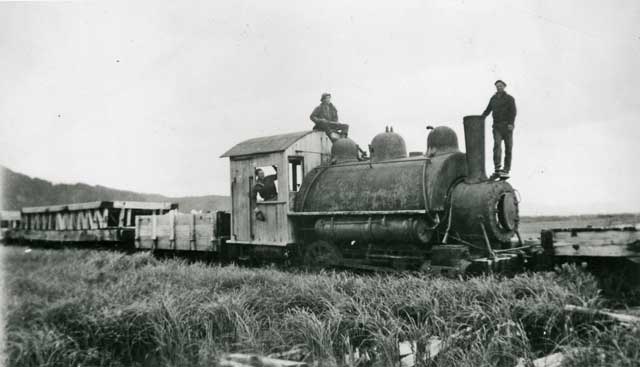 |
CRNW Engine #3 on the abandoned Alaska Anthracite Coal line near
Katalla, where it was left in place in 1922.
--Cordova Museum |
“The
dinkies? Most of those original construction-era saddle tanks were sold
off and shipped out. Of the two still in the country, No. 4 is kept at
the Cordova roundhouse. No. 3 was sold to the Alaska Anthracite Railroad
near Katalla. That operation failed in 1922 and engine no. 3 now sits
abandoned out in the tundra near the Bering River.”
Now,
102 stood contentedly puffing steam, ready on a siding to the north to
attach itself to the rear of this large consist once the train was
fully positioned to begin its final push up the hill. The engineer sent
out a loud series of blasts.
“Time
for you guys to board.”
Mike
extended his hand to the two men.
“It’s
been great meeting you. I learned something new. Good luck at
Kennecott.”
The
long consist was still on level ground, but as the two engines began
working the train north, the lead engine entered the first steep
incline, and the train began the slow run for the remaining four and a
half miles.
The
passengers had a good view of the deserted town of Blackburn, a small
grouping of log structures including one large, abandoned, two-story log
hotel. In the background, the rock covered glacier rose well above the
abandoned structures. The train climbed another 600 feet. Those last
four miles represented a greater rise in elevation than in the first 131
miles from Cordova to Chitina. This lofty view allowed a brief but
magnificent panoramic glimpse of Kennicott Glacier from above. As the
track approached Kennecott, however, the elevation of the glacier began
to exceed that of the railbed. By the time the train reached Kennecott,
the glacier towered over the train.
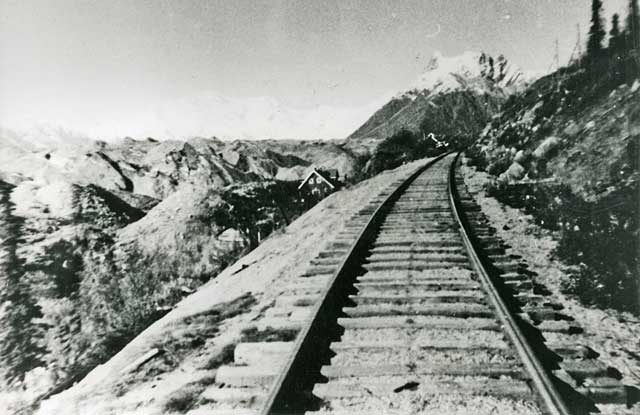 |
Approaching Kennecott,
Kennicott Glacier on the right --UAF Archives |
The
train passed a quarantine area used to isolate passengers during the
Spanish Flu epidemic. That practice was finally abandoned by the early
1920s. Just beyond, the dairy barn marked the beginning of Kennecott.
Just beyond, the rails passed the five-plex apartments and a number of
cottages--all built along a steep hillside across from the glacier.
There
were more cottages along the glacial moraine on the right, centering on
the recreation hall. Beyond those cottages was a series of freight
yards for coal, wood and oil drums. At the end of the large storage
area was the three-story west barrack, which towered over a small
schoolhouse and an adjacent ball field. The barrack was large, but it
was nearly overwhelmed by the daunting presence of the glacier which
appeared to be a massive series of rounded, rock-covered hills
interspersed with walls of ice.
The mounds
look like huge, sleeping ancient monsters waiting for the right moment
to return to life and overtake everything the white man has built here.
“What
do you think, Cap? You’re looking awfully hard at something.”
“I was
just noticing how even these large buildings seem so small compared to
the mountain glacier. It just sits there like a silent menace.”
“Wild,
isn’t it?”
“Interesting place. I think I like it. Awfully busy up here,
Sla’cheen.”
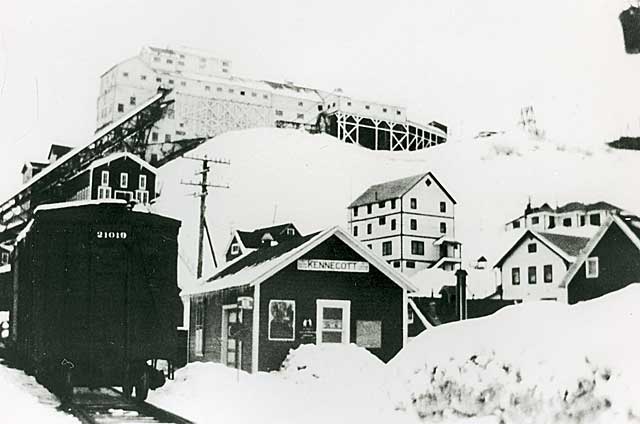 |
Arrival at Kennecott: the West Barrack is on the left. In front
of it is the school house. The mill is on the right. Beyond is
the tall ice-mounds that mark the eastern edge of the Kennicott
Glacier as it was in the 1920s. --UAF Archives
|
BELOW: The abandoned
Kennecott depot in 1955 |
 |
|
The
train stopped at a small telegraph station on the south side of National
Creek. All the passengers were checked there and directed to their
destinations. Johnny followed Cap as they stepped off the train onto
the ground. There was no large platform like the ones at Chitina and
McCarthy.
“What
an overpowering presence !”
Johnny
was remarking about the appearance of the fourteen-story mill building
which towered above all else. The bright midday summer sun accentuated
the peeling and fading paint on the upper reaches of the tall wooden
structure. It was clearly in need of a new paint job. Below the were a
series of stately buildings following a long walkway up a hill toward
what appeared to be a log dam about a quarter-mile away.
At the
diminutive telegraph station, a very gaunt, older man stood looking up
and smiling.
“Father, it’s only been about a month, but it seems like it’s been
longer.”
Johnny was
shocked at how thin and old-looking his dad had become. It was
certainly good to see a friendly, familiar face. The two embraced. Emil
had known Cap since the boys were both very young. The two also hugged
each other. This was unusual for the stand-offish Cap.
“Boys,
it is so good to see you both. I’m so pleased you’ll both be working
here. You’re working under me, you know. Your sponsor, Frank Buckner,
arranged everything. He even let me know you’d be coming on this
train.”
“How
could he possibly know which train we would be coming on?”
“The
stationmaster at the junction telegraphed this station when you two
checked in. The station notified the office. Frank came down the hill
to let me know. So here I am. And here you are. You two both look
great. I guess there’s a lot to be said for hard work. Looks like
Green Butte did well for you. I am so thrilled to see you both.”
“Dad,
it just worked out well. We both decided we wanted to be here. Green
Butte turned out to be the key. We made a little money and learned
something about hard-rock mining .”
“McCarthy take all your money?”
“Dad,
how’d you know?”
 |
The 1924 Kennecott power plant fire
--W.A. Richelsen |
“I
figured it out. Frank kept track of the telegrams every day. When you
said you were coming and you failed to show, he became alarmed and told
me. I thought about it for awhile. Then I realized what I would’ve
done when I was your age.”
“It
sure is good to see you again, Dad. It’s really been too long.”
“I
took time to visit you at McCarthy last month, remember?”
“The
speeder visit? That was a quick trip.”
“Couldn’t have done it without the railroad. Anyway, you’ll be helping
the carpenters build the new powerhouse. When it’s up, you’ll be on my
paint crew. That’s the big job. We just got done last year painting the
remodeled plant.”
“That
must have been frustrating.”
It
was. The engineers made the mistake of allowing a composite roof. It
ignited a few months after we finished building it. At least, that’s
what they think happened. Just to be on the safe side, we won’t be
repeating that expensive mistake. There’s large load of corrugated
steel roofing on board this train, I believe. It surely won’t burn.”
“Dad,
you’re involved in the big rebuilding job?”
“I’m
not just the head painter, but I’m the assistance carpenter foreman. We
have a very nice young man in charge named Christopher Jensen. He’s
quite the carpenter. Chris requested you for this crew. We need to go
to the office first, then I’ll get you checked into a room.”
The
tracks headed in a nearly straight line to the north, passing through a
two-story covered loading dock at the base of the mill. As the three of
them finished the conversation, Sal Reed began pulling the consist
through the loading dock.
The
noise of the huge engine masked the roar of the creek rushing
through a flume
of heavy wood timbers. The flume directed the roaring water under the
trestle toward a wood crib dam. The water spilled over the dam,
disappearing under Kennicott Glacier about 300 feet away from the
railroad trestle.
The
three men stepped off track grade, following a road which paralleled
the trestle on the upstream side. The path crossed the creek at a
wagon bridge, then continued toward a wooden stairway which climbed
toward the office near the lower end of the 150-foot tall mill.
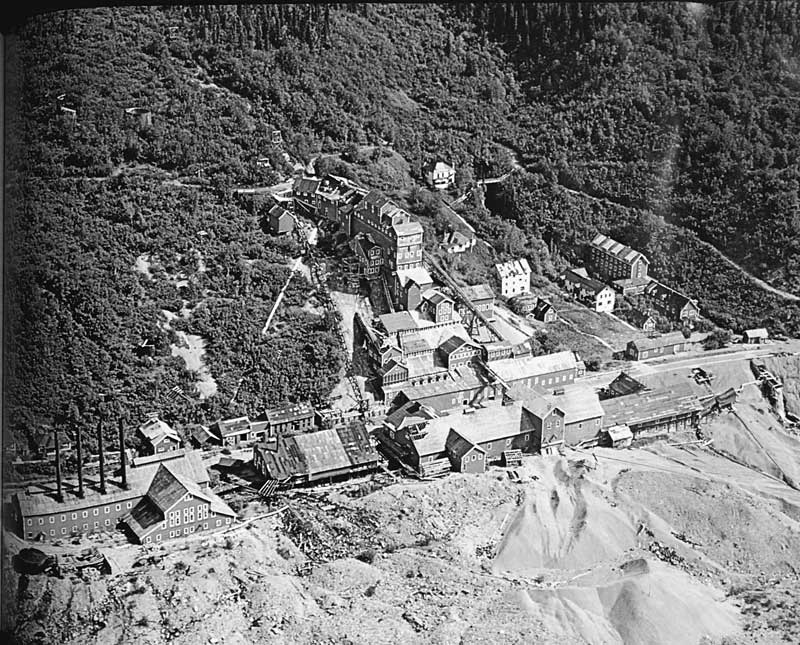
George Herben photo of abandoned Kennecott in the early 1960s
Continue |
No comments:
Post a Comment